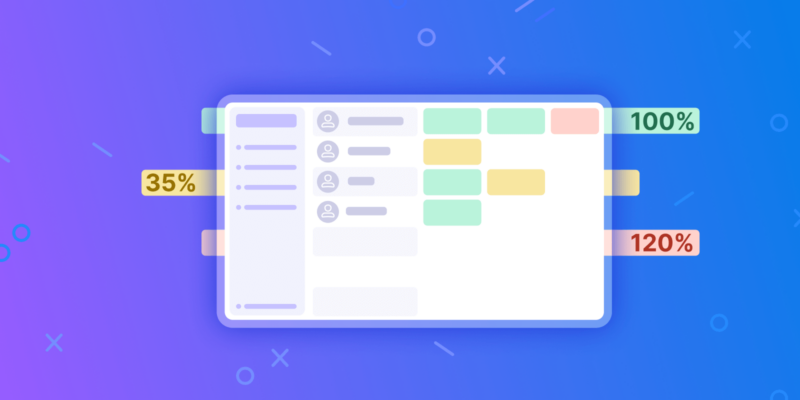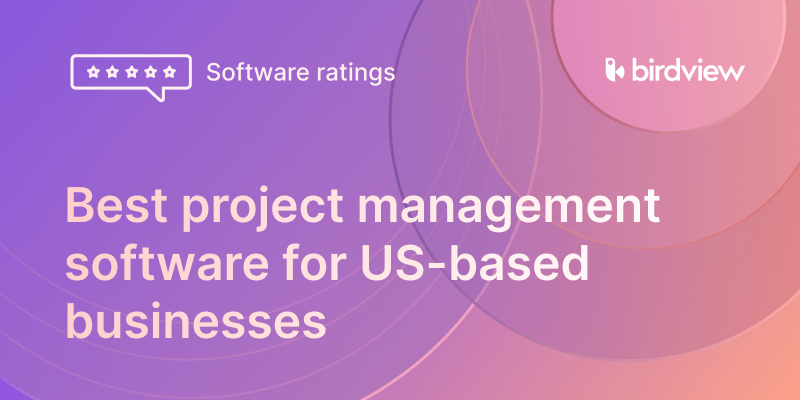For US businesses, resource planning has never been more challenging. Hybrid and remote work, unpredictable client demand, and stricter compliance rules like SOC 2 and HIPAA all add pressure. On top of that, leaders need to keep teams engaged while making sure billable hours stay healthy and projects remain profitable.
The challenges are real and varied: unpredictable client demand, stringent compliance requirements like SOC 2 and HIPAA, and the constant need to prevent employee burnout while meeting project deadlines. Traditional spreadsheet-based resource planning simply can’t keep up with these demands.
This article will walk you through the key features to look for, share pro tips to maximize your investment, and compare the best resource management software for US businesses in 2025.
Key features to look for in resource management tools
When evaluating resource management software, certain features are non-negotiable for US businesses. Here’s what should be on your must-have list:
Real-time Visibility and Reporting
Your resource management tool should provide crystal-clear insights into current workloads, team availability, and utilization rates. Real-time dashboards allow managers to make informed decisions quickly, identifying bottlenecks before they impact project delivery. Look for tools that offer customizable reporting features that can be tailored to different stakeholders, from project managers to C-suite executives.
Capacity Planning and Demand Forecasting
The ability to balance staffing levels with changing project needs is crucial for maintaining profitability. Effective capacity planning features help you anticipate future resource requirements based on historical data, pipeline projects, and seasonal trends. This predictive capability enables proactive hiring decisions and prevents last-minute scrambling for talent.
Skill- and Role-Based Assignments
Not all team members are interchangeable. The best resource management tools allow you to match people with the right expertise to the right tasks. This includes maintaining detailed skill inventories, tracking certifications and experience levels, and automatically suggesting optimal resource assignments based on project requirements and individual capabilities.
Time Tracking and Utilization Analysis
Measuring productivity, profitability, and billable hours accurately is essential for US businesses focused on maximizing revenue. Look for integrated time tracking that seamlessly captures both billable and non-billable hours, provides utilization analytics, and helps identify opportunities for improved efficiency.
Scenario Planning and Conflict Detection
The ability to test “what-if” scenarios before committing resources can save both time and money. Advanced tools offer conflict detection to prevent double-bookings and allow you to model different staffing scenarios to find the optimal approach. This feature is particularly valuable when dealing with multiple concurrent projects or seasonal demand fluctuations.
Compliance, Integrations, and Ease of Use
For US businesses, compliance isn’t optional. Your resource management tool should support relevant standards like SOC 2, GDPR, and HIPAA where applicable. Equally important are smooth integrations with existing business systems like QuickBooks, Salesforce, and Slack, plus intuitive interfaces that minimize training time and maximize adoption.
Best resource management tools for US-based businesses
Here are the top resource management solutions specifically recommended for US businesses, each offering unique strengths for different organizational needs.
| Tool | Best For | Key Features | Trial Information |
|---|---|---|---|
| Birdview PSA | Consulting firms, agencies, and professional services organizations needing end-to-end project delivery | Real-time drag-and-drop resource allocation; Skills-based assignments with competency tracking; Utilization dashboards; Native CRM & accounting integrations (Salesforce, QuickBooks) | 28-day free trial and personalized demos with your own data |
| PDWare ResourceFirst | Large enterprises with complex portfolios and advanced forecasting needs | Scenario planning; Demand forecasting- Capacity heatmaps; Conflict detection & resource leveling | Structured pilot programs or consultation-based trials |
| Forecast | Agencies and professional services firms wanting AI-powered automation | AI auto-scheduling; Utilization dashboards; Scenario planning; Time tracking & project budgeting | 14-day free trial, full access, no credit card |
| Adobe Workfront | Marketing, creative, and enterprise teams (especially those using Adobe Creative Cloud) | Resource dashboards & capacity planning; Project scheduling; Time tracking | Free trials and customized demos via Adobe sales |
| Scoro | Agencies and consultancies needing an all-in-one platform (resource + CRM + billing) | Resource scheduling & utilization tracking; Time & expense tracking; Dashboards & reporting | 14-day free trial with full access, including billing & CRM |
| Float | Agencies and creative teams seeking a simple, visual scheduling tool | Drag-and-drop scheduling; Capacity management; Time-off tracking | 14-day free trial with full access to core features |
1. Birdview PSA
Birdview PSA is a comprehensive Professional Services Automation platform that covers the complete project delivery lifecycle from initial planning through final billing. This end-to-end approach makes it particularly suitable for US consulting firms, agencies, and professional services organizations that need integrated resource planning, forecasting, and profitability analysis.
Key Features:
- Real-time resource allocation with drag-and-drop scheduling
The platform lets you visually assign team members to projects with simple drag-and-drop functionality that instantly updates everyone’s availability.
- Skills-based resource assignments with competency tracking
Detailed skill inventories are maintained for each team member, with Birdview automatically suggesting the best person for each task based on their expertise.
- Integrated time and expense tracking
Billable hours and project costs are captured within the same platform, eliminating the need for separate time tracking tools.
- Comprehensive utilization dashboards
You get instant visibility into team workloads, showing who’s overloaded, who has capacity, and overall productivity metrics.
- Native integrations with popular CRM and accounting systems
Direct connections with tools like Salesforce and QuickBooks work without requiring complex setup or custom development.
Trial Information: Free trial and personalized demos are available, allowing you to test the platform with your actual data before committing.
2. PDWare ResourceFirst
ResourceFirst focuses specifically on enterprise-level resource planning with particularly strong capabilities in forecasting and scenario planning. This makes it an excellent choice for larger US organizations with complex resource allocation needs and multiple project portfolios.
Key features: Scenario planning, demand forecasting, capacity heatmaps, conflict detection, resource leveling, Microsoft ecosystem integrations, and enterprise compliance.
Trial Information: PDWare typically offers ResourceFirst through consultation sessions or structured pilot programs, allowing for customized evaluation periods.
3. Forecast
Forecast leverages artificial intelligence to automate much of the resource planning process, making it particularly popular with agencies and professional services firms that want to reduce manual scheduling overhead. The AI-powered features learn from historical data to make increasingly accurate resource allocation suggestions.
Key features: AI auto-scheduling, utilization dashboards, scenario planning, time tracking, project budgeting, Jira/Slack/Salesforce integrations, and compliance features.
Trial Information: 14-day free trial available with full feature access, no credit card required.
4. Adobe Workfront
Adobe Workfront excels in enterprise work management with particularly strong resource planning capabilities for marketing, creative, and large enterprise teams. The deep integration with Adobe Creative Cloud makes it an obvious choice for creative agencies and marketing departments.
Key features: Resource dashboards, capacity planning, project scheduling, time tracking, approval workflows, Adobe Creative Cloud integration, and enterprise security.
Trial Information: Free trials and customized demos are available through Adobe’s sales team, with options for extended evaluation periods.
5. Scoro
Scoro takes an all-in-one approach, combining resource management with project management, billing, and CRM functionality. This integrated approach makes it particularly suitable for agencies and consultancies that want to minimize the number of separate tools they need to manage.
Key features: Resource scheduling, utilization tracking, time and expense tracking, billing and quoting, dashboards and reporting, CRM, integrations, and compliance support.
Trial Information: 14-day free trial with full access to all features, including billing and CRM capabilities.
6. Float
Float focuses on visual simplicity and ease of use, making it an excellent choice for agencies and creative teams that need straightforward drag-and-drop resource planning without complex enterprise features.
Key features: Drag-and-drop scheduling, capacity management, time-off tracking, utilization charts, Asana/Trello/Slack integrations, mobile access, conflict detection.
Trial information: 14-day free trial available with immediate access to all core features.
Pro tips to get the most out of your resource planning software
Implementing resource management software is just the first step. Here are proven strategies to maximize your return on investment:
1. Start with Clean, Accurate Data
Your resource planning is only as good as your underlying data. Before implementing any new system, invest time in cleaning up schedules, updating PTO records, and accurately documenting team members’ roles and skill sets. This foundation of accurate data will dramatically improve forecast accuracy and resource allocation decisions.
2. Align Utilization Targets with Business Goals
While it’s tempting to push for maximum utilization, setting realistic thresholds is crucial for maintaining both profitability and employee well-being. Consider factors like professional development time, administrative tasks, and the need for creative thinking space when establishing utilization targets. Most successful US agencies and consultancies target 70-85% utilization rather than pushing for unrealistic 100% rates.
3. Leverage Scenario Planning Before Major Decisions
Before committing to new projects or making significant staffing changes, use your software’s scenario planning features to test different approaches. This might involve modeling the impact of taking on a large new client, exploring the effects of hiring additional team members, or assessing how seasonal demand changes might affect resource needs.
4. Integrate Compliance and Financial Systems Early
Don’t wait until year-end to connect your resource management tool with accounting, CRM, and HR systems. Early integration saves time, reduces data entry errors, and ensures you’re meeting regulatory requirements from day one. This is particularly important for US businesses dealing with complex compliance landscapes.
Making the right choice for your business
Effective resource management software is a strategic investment that can significantly boost profitability, ensure compliance with US regulatory requirements, and provide the flexibility needed for today’s hybrid and remote teams. For US businesses, the stakes are particularly high with compliance demands, remote work challenges, and rising client expectations.
The key to success lies in choosing a solution that aligns with your specific business size, industry requirements, and compliance needs. The smartest approach is to test a few top platforms before making a final call. Take advantage of free trials and demos, involve your team early, and measure how well each tool fits into your daily workflow. Remember that the best software is the one your people will actually use consistently.
Focus on ease of adoption, scalability, and clear reporting capabilities when making your final decision. Remember that the best resource management tool is the one your team will actually use consistently. Factor in training requirements and long-term growth potential to ensure your choice supports sustainable business success.
Further Reading



